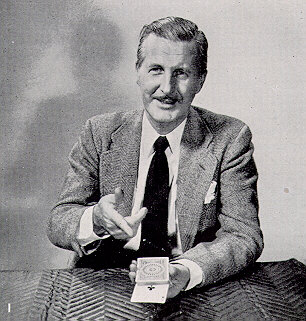Dai Vernon (David Frederick Wingfield Verner)

Dai Vernon was born in Ottawa as David Frederick Wingfield Verner. While performing, he often mentioned that he had learned his first trick from his father at age seven, adding that he had “wasted the first 6 years” of his life. His father was a government worker and an amateur magician. Vernon studied mechanical engineering at the Royal Military College of Canada in Kingston, Ontario, but by World War I he had moved to New York City. Vernon first fell in love with magic when he was seven years old after his father took him to see a magic show. The first real magic book he ever owned was an early edition of perhaps the most famous card book of them all, The Expert at the Card Table, by S. W. Erdnase. By the time he was 13 he had memorized the contents of the book. He also had a famous encounter with another up-and-coming young magician from his town, Cliff Green, who asked Vernon, “What kind of magic do you do?” Dai Vernon responded by asking the boy to name a card. Upon pulling a pack of cards from his pocket, Vernon turned over the top card of the deck to reveal the named card and replied to the speechless Green, “That’s the kind of magic I do. What kind of magic do you do?” As a young man, Vernon moved to New York where, in the back room of Clyde Powers’ magic shop, he found favor among many of the great magicians of the era, including Dr. James William Elliott and Harry Kellar. He began to use the first name “Dai” after a newspaper used the name in place of “David”; the paper actually was using the Welsh nickname for David. When Verner first moved to the United States, the male member of a popular ice-skating pair had the surname Vernon; Americans continually mistook Verner’s last name to be the same as the popular ice skater, and eventually the magician became fed up with correcting people and simply adopted “Vernon” as well.
Owing to his extraordinary knowledge of, and skill at, sleight of hand, Vernon has long been affectionately known as The Professor. Harry Houdini (who in his early years billed himself as “The King of Kards”) often boasted that if he saw a card trick performed three times in a row he would be able to figure it out. Vernon then showed Houdini a trick where he removed the top card of the deck and placed it second from the top, then turned over the top card to again reveal the original card. Houdini watched Vernon do the trick seven times, each time insisting that Vernon “do it again.” Finally, Houdini’s wife and Vernon’s friends said, “Face it, Houdini, you’re fooled.” For years afterward, Vernon used the title The Man Who Fooled Houdini in his advertisements. Dai Vernon spent most of his life traveling all over the United States of America looking for card cheats, and anyone who might know anything about sleight-of-hand with cards. Dai Vernon was famously under-credited for much of the work published in Jean Hugard and Frederick Braue’s Expert Card Technique,[4] though a later edition included an extra chapter which acknowledges Vernon’s contributions. In fact, a huge portion of the sleight-of-hand had been discovered by Vernon over years of searching. Among magicians, he is credited with inventing or improving many standard close-up effects with cards, coins, and other small items. The “standard” Cups and balls routine is his, and his 6-ring “Symphony of the Rings” remains one of the most popular Chinese linking rings routines in use to this day. Vernon spent the last thirty years of his life as Magician-in-Residence at The Magic Castle in Los Angeles, California. There he mentored numerous well-known magicians including Ricky Jay, Persi Diaconis, Doug Henning, Larry Jennings, Bruce Cervon, Michael Ammar and John Carney. He died on August 21, 1992 in Ramona, County of San Diego, California. He was cremated, and his ashes are interred at the Magic Castle.
Born
- June, 11, 1894
- Canada
- Ottawa, Ontario
Died
- August, 21, 1992
- USA
- Ramona, California

